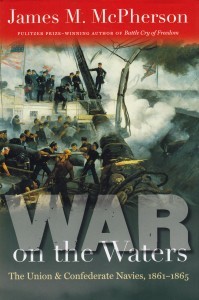 By James M. McPherson, University of North Carolina Press, Chapel Hill NC, (2012).
By James M. McPherson, University of North Carolina Press, Chapel Hill NC, (2012).
Reviewed by Kenneth J. Blume, Ph.D.
Do we need yet another book about the naval side of the Civil War? When the book has been written by the nation’s preeminent scholar of the Civil War, the answer is certainly yes. James M. McPherson, well known for such works as Battle Cry of Freedom, For Cause and Comrades, and Tried by War, now offers War on the Waters, a volume that compresses a complex topic into 226 pages of text and skillfully merges the “big picture” with specific themes, colorful quotations, and powerful vignettes.
McPherson declares on page 1 that “the Union deserves more credit for Northern Victory than it has traditionally received.” He concludes by saying: “the war could not have been won without the contributions of the navy.” (p. 226) Subscribers to Naval History Book Reviews will not disagree.
Nevertheless, McPherson demonstrates that this is not the story of guaranteed naval victory. The narrative charts the ebb and flow of successes and failures, and the changing mix in which some Union victories were almost exclusively naval, while some were achieved through “combined operations.” McPherson provides concise pictures of the major naval actions on inland waterways, along the coasts, and on the high seas. His eight-page introduction provides a remarkable summary of the naval war. The following eleven chapters provide a roughly chronological account of the main theaters, issues, and characters of the naval war.
McPherson provides a clear glimpse of virtually every significant naval issue during the war and sensible assessments of big questions and specific problems. Who “won” the Battle of Hampton Roads between Virginia and Monitor? McPherson awards a tactical victory to Monitor for accomplishing its mission of protecting the wooden warships. But he awards a strategic victory to Virginia for “infecting many Union naval officers with ‘ram fever’ that inhibited their aggressiveness whenever Confederate ironclads were in the vicinity—or were suspected to be.” (p.105) Or, did Admiral Farragut actually shout “Damn the torpedoes! Full speed ahead!” at Mobile Bay? “Whether Farragut said these words or not, he certainly did order the Hartford to go ahead.” (p. 210)
On big the big issues, McPherson has measured and informed judgments. One-twelfth of the Union’s military spending was for naval operations. “By any measure of cost-effectiveness,” McPherson writes, “the nation got more than its money’s worth.” (p.224). The destruction brought about by Confederate commerce raiders and privateers “did not significantly hinder the Union war effort,” even though they “did weaken the blockade by diverting its ships into fruitless hunts for the raiders and cripple the merchant marine.” (p. 224) But in comparing Confederate and Union accomplishments on the waters, McPherson gives the prize to the Union, noting that Confederate “achievements paled in comparison with the Union navy’s contribution to Northern military operations. (224) Finally, McPherson concludes that the blockade was “a crucial factor in the war’s outcome. . . . The most important statistic is not how many blockade-runners got through, but how many ships and how much cargo would have come in and gone out of Confederate ports if there had been no blockade.” (pp. 224-5)
McPherson’s mastery of the vast literature on the Civil War yields memorable zingers. For example, Commander David Dixon Porter on his 60-year-old foster brother, David Glasgow Farragut: “Men of his age in a seafaring life are not fit for the command of important enterprises, the lack the vigor of youth.” (p. 56) Or, Porter on the capture of New Orleans: “New Orleans falling seems to have made a stampede in ‘Secessia’ . . . You may put the rebellion down as ‘spavined,’ ‘broken-backed’ and ‘wind-galled.’” (pp. 66-67)
And McPherson has a knack for finding quotations that capture the conditions facing Civil War seamen. One Union sailor wrote that he was “favored with a large company of cockroaches….They devour all the provisions I buy. They eat my thread, clothes & paper & I think they tried to devour my needles….I have become so used to them that I can go to sleep while they are performing pedestrian tours up my legs and over my body generally.” (p.188) Another summed up conditions aboard an ironclad: “A man who would stay in an ironclad from choice is a candidate for the insane asylum, and he who stays from compulsion is an object of pity.” (p. 209) And another described a Confederate vessel after the battle of Mobile Bay: “her decks looked like a butcher shop. One man had been struck by the fragments of one of our 15-inch shot, and was cut into pieces so small that the largest would not have weighed 2 lbs.” (p. 212)
Individual readers will of course say “why didn’t he include…..?” But in truth, McPherson has included the essentials. All I would like is a special illustrated version of this book, similar to the special illustrated edition of Battle Cry of Freedom.
The is not a work of revisionism, but rather a mature and sensible synthesis of 150 years of writing about what McPherson calls “the asymmetrical war on the waters” (p. 224) It’s a noteworthy achievement.
Dr. Blume is a Professor of History, Dept. of Humanities, Albany College of Pharmacy and Health Sciences.

